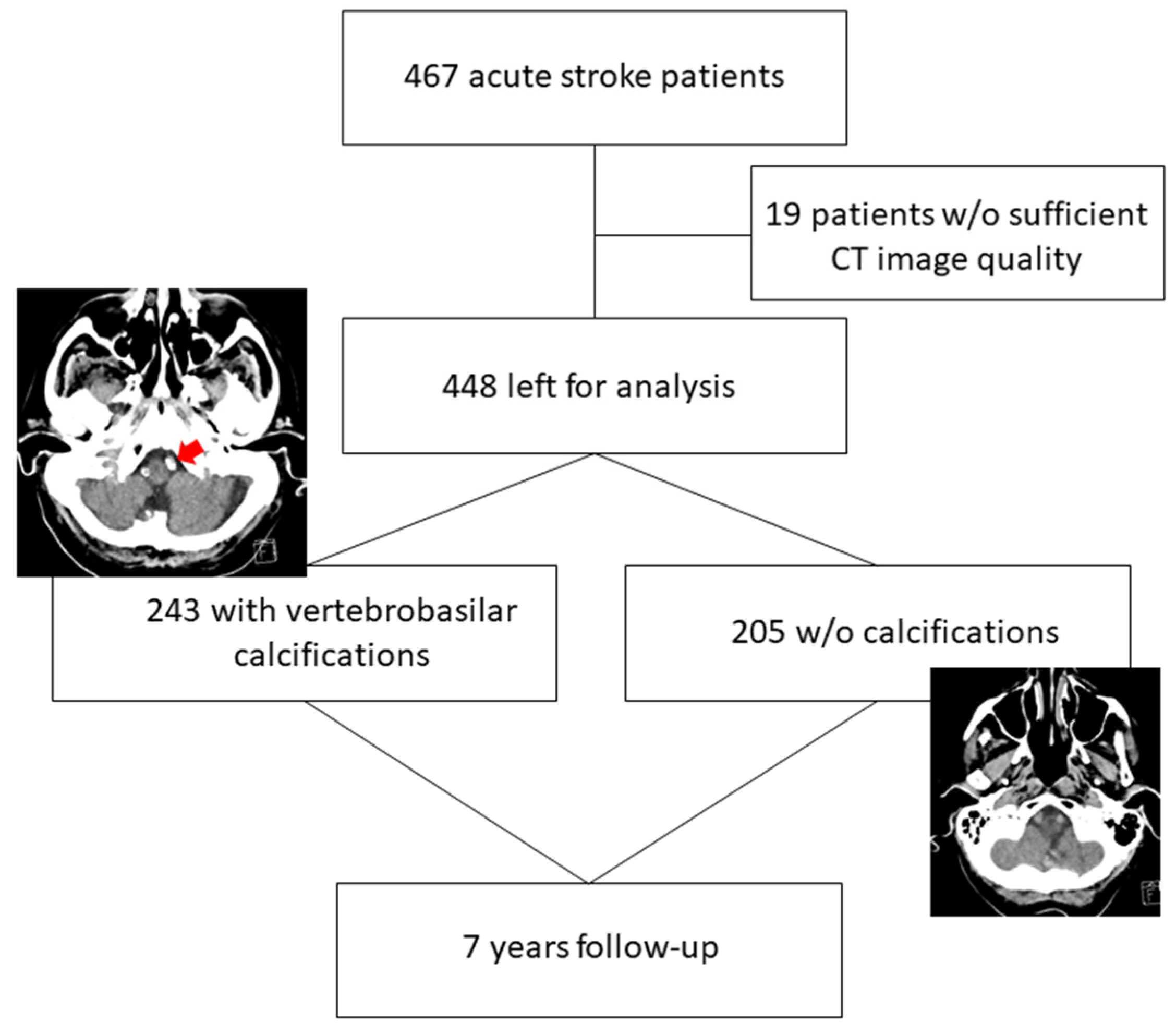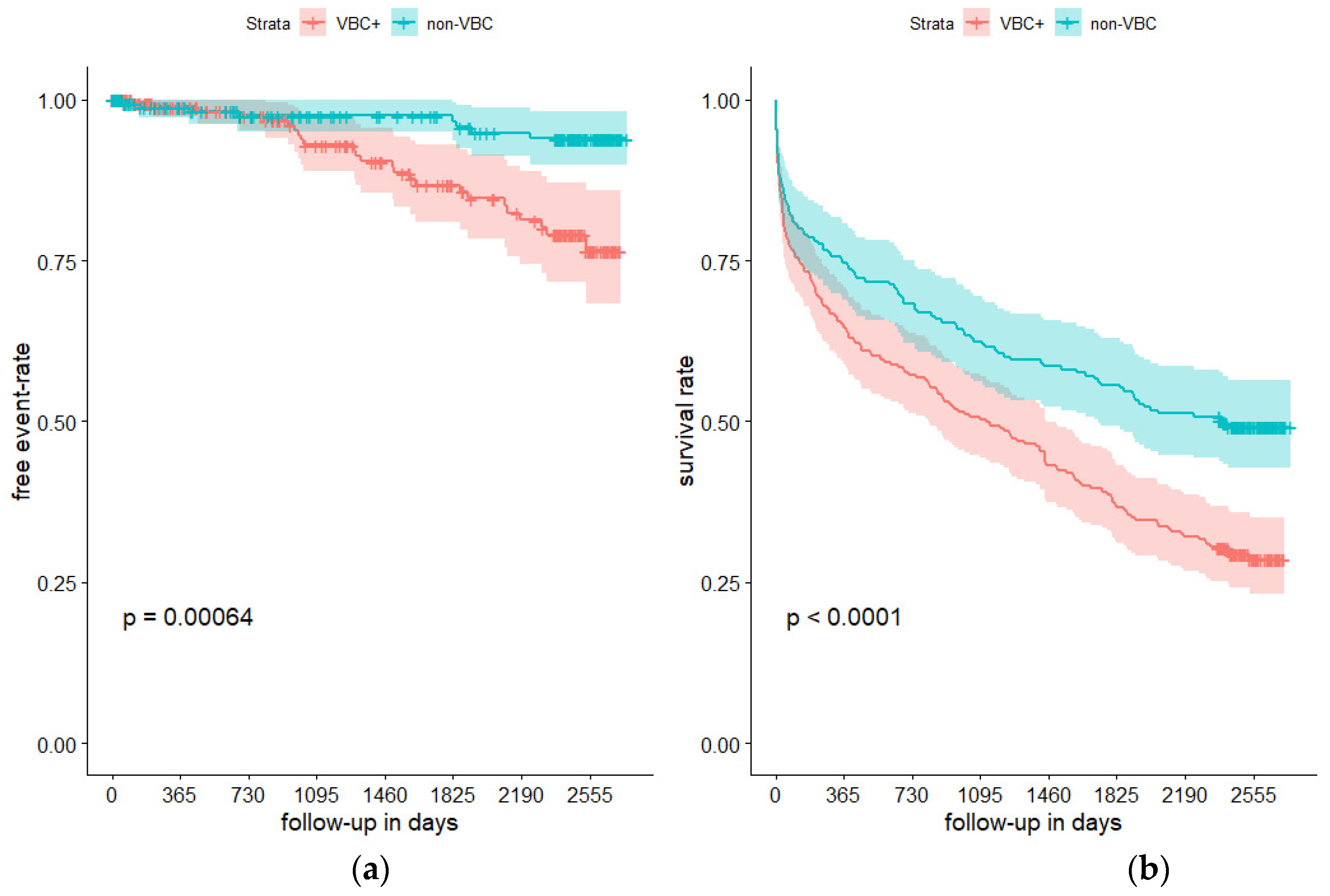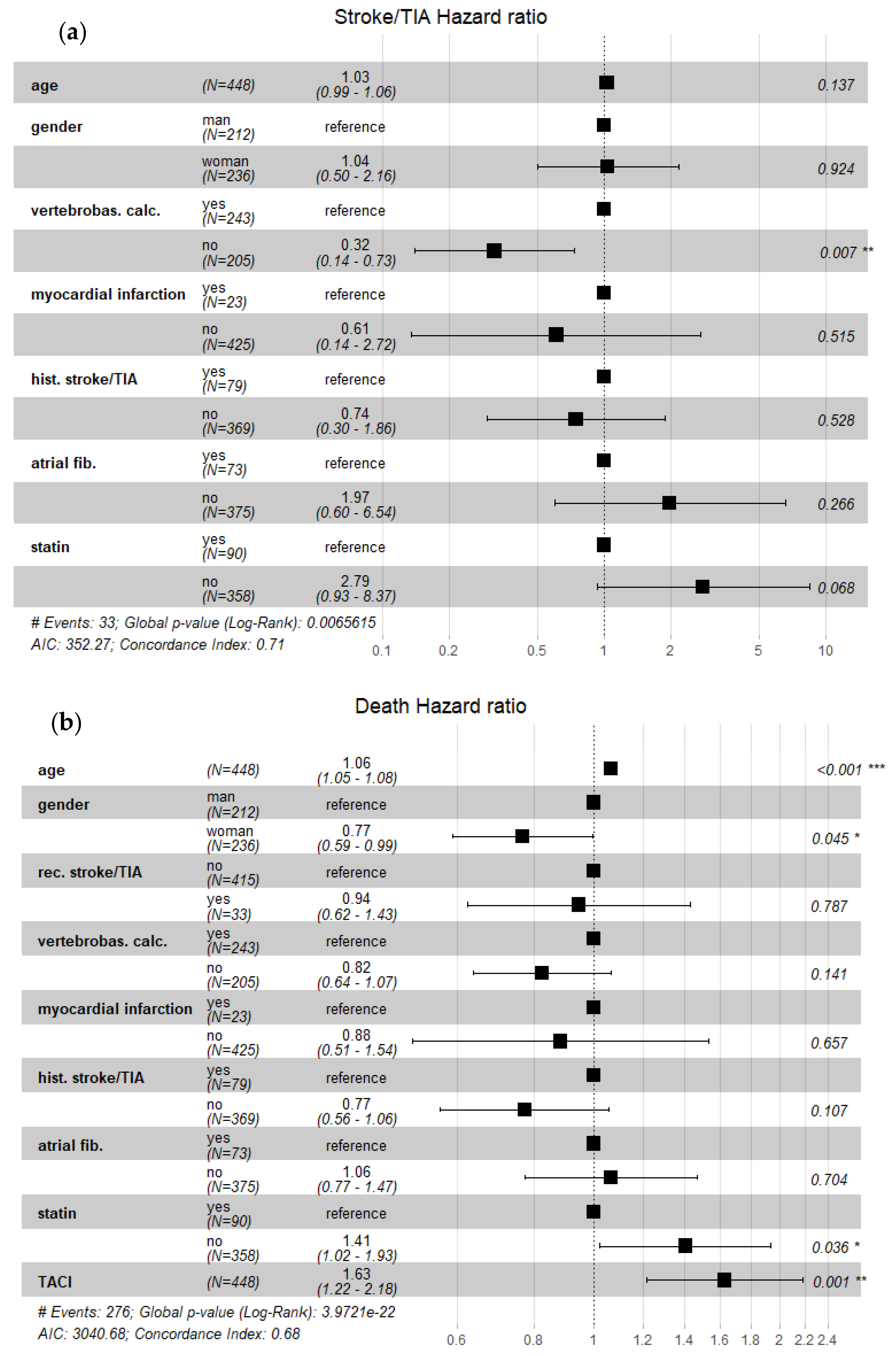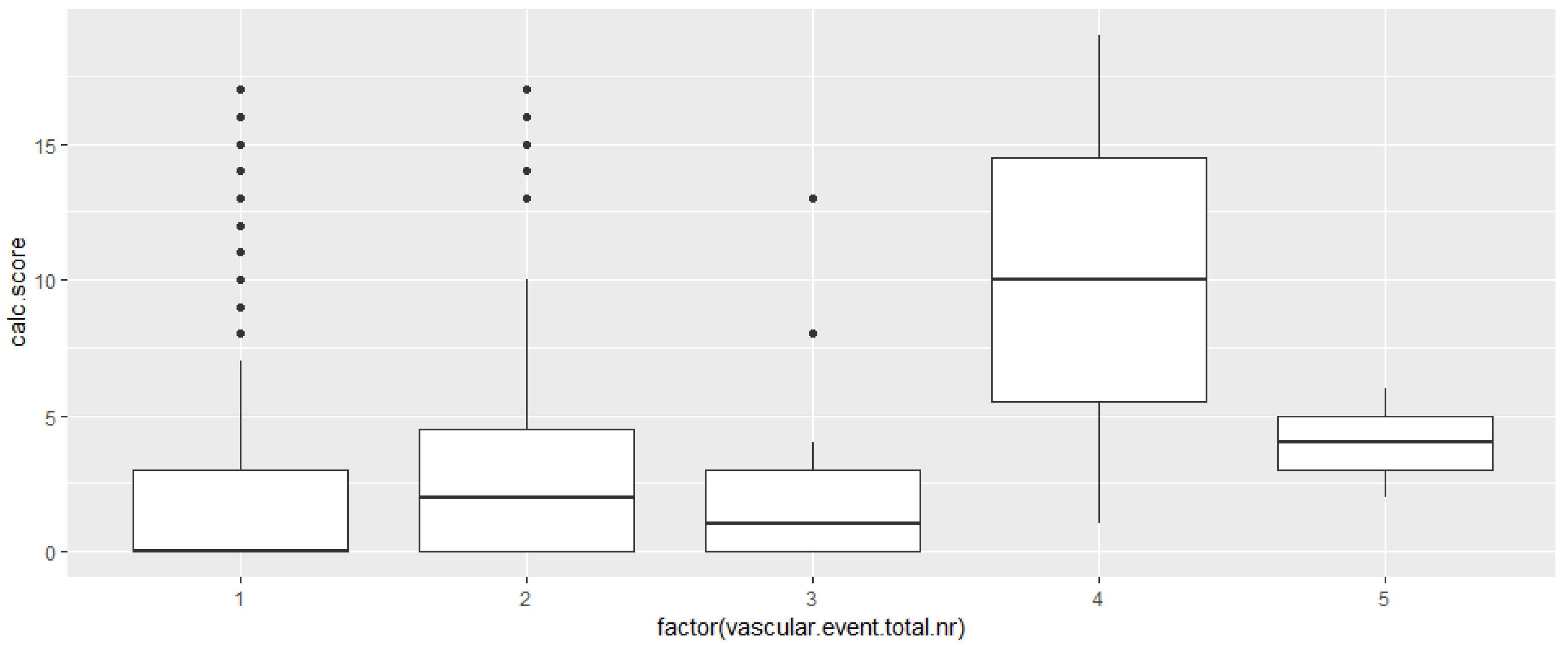Intracranial Vertebrobasilar Calcification in Patients with Ischemic Stroke Is a Predictor of Recurrent Stroke, Vascular Disease, and Death: A Case-Control Study
Abstract
1. Introduction
2. Materials and Methods
2.1. Patient Cohort
2.2. Evaluation of Intracranial Calcification
2.3. Case-control Study
2.4. Statistical Analysis
3. Results
3.1. Study Cohort
3.2. Characteristics of Patients with Vertebrobasilar Calcification
3.3. Follow-up and Clinical Outcome
3.4. Etiology of Recurrent Stroke
3.5. Risk for Subsequent Vascular Events
4. Discussion
5. Conclusions
Author Contributions
Funding
Acknowledgments
Conflicts of Interest
References
- Jemal, A.; Ward, E.; Hao, Y.; Thun, M. Trends in the leading causes of death in the United States, 1970–2002. Jama 2005, 294, 1255–1259. [Google Scholar] [CrossRef] [PubMed]
- Tesauro, M.; Mauriello, A.; Rovella, V.; Annicchiarico-Petruzzelli, M.; Cardillo, C.; Melino, G.; Di Daniele, N. Arterial ageing: From endothelial dysfunction to vascular calcification. J. Intern. Med. 2017, 281, 471–482. [Google Scholar] [CrossRef] [PubMed]
- Gallino, A.; Stuber, M.; Crea, F.; Falk, E.; Corti, R.; Lekakis, J.; Schwitter, J.; Camici, P.; Gaemperli, O.; Di Valentino, M.; et al. “In vivo” imaging of atherosclerosis. Atherosclerosis 2012, 224, 25–36. [Google Scholar] [CrossRef] [PubMed]
- Arenillas, J.F.; Dieleman, N.; Bos, D. Intracranial arterial wall imaging: Techniques, clinical applicability, and future perspectives. Int. J. Stroke: Off. J. Int. Stroke Soc. 2019. [Google Scholar] [CrossRef]
- Kim, J.M.; Park, K.Y.; Bae, J.H.; Han, S.H.; Jeong, H.B.; Jeong, D. Intracranial Arterial Calcificationes Can Reflect Cerebral Atherosclerosis Burden. J. Clin. Neurol. 2019, 15, 38–45. [Google Scholar] [CrossRef]
- Koton, S.; Tashlykov, V.; Schwammenthal, Y.; Molshatzki, N.; Merzeliak, O.; Tsabari, R.; Tanne, D. Cerebral artery calcification in patients with acute cerebrovascular diseases: Determinants and long-term clinical outcome. Eur. J. Neurol. 2012, 19, 739–745. [Google Scholar] [CrossRef]
- Pikija, S.; Magdic, J.; Knific, A. Are arterial calcifications a marker of remodeling in vertebrobasilar territory? Stroke 2014, 45, 874–876. [Google Scholar] [CrossRef]
- Pikija, S.; Magdic, J.; Hojs-Fabjan, T. Calcifications of vertebrobasilar arteries on CT: Detailed distribution and relation to risk factors in 245 ischemic stroke patients. Biomed Res. Int. 2013, 2013, 918970. [Google Scholar] [CrossRef]
- Vos, A.; Van Hecke, W.; Spliet, W.G.; Goldschmeding, R.; Isgum, I.; Kockelkoren, R.; Bleys, R.L.; Mali, W.P.; De Jong, P.A.; Vink, A. Predominance of Nonatherosclerotic Internal Elastic Lamina Calcification in the Intracranial Internal Carotid Artery. Stroke 2016, 47, 221–223. [Google Scholar] [CrossRef]
- Kockelkoren, R.; Vos, A.; Van Hecke, W.; Vink, A.; Bleys, R.L.; Verdoorn, D.; Mali, W.P.; Hendrikse, J.; Koek, H.L.; De Jong, P.A.; et al. Computed Tomographic Distinction of Intimal and Medial Calcification in the Intracranial Internal Carotid Artery. PLoS ONE 2017, 12, e0168360. [Google Scholar] [CrossRef]
- Lee, J.G.; Lee, K.B.; Roh, H.; Ahn, M.Y.; Bae, H.J.; Lee, J.S.; Woo, H.Y.; Hwang, H.W. Intracranial arterial calcification can predict early vascular events after acute ischemic stroke. J. Stroke Cerebrovasc. Dis.: Off. J. Natl. Stroke Assoc. 2014, 23, e331–e337. [Google Scholar] [CrossRef] [PubMed]
- Bugnicourt, J.M.; Leclercq, C.; Chillon, J.M.; Diouf, M.; Deramond, H.; Canaple, S.; Lamy, C.; Massy, Z.A.; Godefroy, O. Presence of intracranial artery calcification is associated with mortality and vascular events in patients with ischemic stroke after hospital discharge: A cohort study. Stroke 2011, 42, 3447–3453. [Google Scholar] [CrossRef] [PubMed]
- Strobl, F.F.; Kuhlin, B.; Stahl, R.; Sabel, B.O.; Helck, A.D.; Schindler, A.; Witt, M.; Bamberg, F.; Reiser, M.F.; Saam, T. Intracranial arterial calcifications as a prognostic factor for subsequent major adverse cardiovascular events (MACE). La Radiol. Med. 2018, 123, 456–462. [Google Scholar] [CrossRef] [PubMed]
- Bos, D.; Portegies, M.L.; Van der Lugt, A.; Bos, M.J.; Koudstaal, P.J.; Hofman, A.; Krestin, G.P.; Franco, O.H.; Vernooij, M.W.; Ikram, M.A. Intracranial carotid artery atherosclerosis and the risk of stroke in whites: The Rotterdam Study. Jama Neurol. 2014, 71, 405–411. [Google Scholar] [CrossRef]
- Gokcal, E.; Niftaliyev, E.; Ozdemir, T.; Kolukisa, M.; Asil, T. The association of vertebrobasilar calcification with etiological subtypes, stroke recurrence and outcome in acute brainstem ischemic stroke. Neurol. I Neurochir. Pol. 2018, 52, 188–193. [Google Scholar] [CrossRef]
- Adams, H.P., Jr.; Bendixen, B.H.; Kappelle, L.J.; Biller, J.; Love, B.B.; Gordon, D.L.; Marsh, E.E., 3rd. Classification of subtype of acute ischemic stroke. Definitions for use in a multicenter clinical trial. TOAST. Trial of Org 10172 in Acute Stroke Treatment. Stroke 1993, 24, 35–41. [Google Scholar] [CrossRef]
- Bamford, J.; Sandercock, P.; Dennis, M.; Burn, J.; Warlow, C. Classification and natural history of clinically identifiable subtypes of cerebral infarction. Lancet 1991, 337, 1521–1526. [Google Scholar] [CrossRef]
- R Core Team (2018). R: A Language and Environment for Statistical Computing; R Foundation for Statistical Computing: Vienna, Austria, 2018. [Google Scholar]
- Gorelick, P.B.; Wong, K.S.; Bae, H.J.; Pandey, D.K. Large artery intracranial occlusive disease: A large worldwide burden but a relatively neglected frontier. Stroke 2008, 39, 2396–2399. [Google Scholar] [CrossRef]
- Sohn, Y.H.; Cheon, H.Y.; Jeon, P.; Kang, S.Y. Clinical implication of cerebral artery calcification on brain CT. Cerebrovasc. Dis. 2004, 18, 332–337. [Google Scholar] [CrossRef]
- Rennenberg, R.J.; Kessels, A.G.; Schurgers, L.J.; Van Engelshoven, J.M.; De Leeuw, P.W.; Kroon, A.A. Vascular calcifications as a marker of increased cardiovascular risk: A meta-analysis. Vasc. Health Risk Manag. 2009, 5, 185–197. [Google Scholar] [CrossRef]
- Babiarz, L.S.; Yousem, D.M.; Bilker, W.; Wasserman, B.A. Middle cerebral artery infarction: Relationship of cavernous carotid artery calcification. Ajnr. Am. J. Neuroradiol. 2005, 26, 1505–1511. [Google Scholar] [PubMed]
- Chwojnicki, K.; Wierucki, L.; Zagozdzon, P.; Wojtyniak, B.; Nyka, W.M.; Zdrojewski, T. Long-term mortality after stroke is higher than after myocardial infarction. Neurol. Sci.: Off. J. Ital. Neurol. Soc. Ital. Soc. Clin. Neurophysiol. 2016, 37, 891–898. [Google Scholar] [CrossRef] [PubMed]
- Reeves, M.J.; Bushnell, C.D.; Howard, G.; Gargano, J.W.; Duncan, P.W.; Lynch, G.; Khatiwoda, A.; Lisabeth, L. Sex differences in stroke: Epidemiology, clinical presentation, medical care, and outcomes. Lancet. Neurol. 2008, 7, 915–926. [Google Scholar] [CrossRef]
- Ni Chroinin, D.; Asplund, K.; Asberg, S.; Callaly, E.; Cuadrado-Godia, E.; Diez-Tejedor, E.; Di Napoli, M.; Engelter, S.T.; Furie, K.L.; Giannopoulos, S.; et al. Statin therapy and outcome after ischemic stroke: Systematic review and meta-analysis of observational studies and randomized trials. Stroke 2013, 44, 448–456. [Google Scholar] [CrossRef] [PubMed]
- Lefer, A.M.; Scalia, R.; Lefer, D.J. Vascular effects of HMG CoA-reductase inhibitors (statins) unrelated to cholesterol lowering: New concepts for cardiovascular disease. Cardiovasc. Res. 2001, 49, 281–287. [Google Scholar] [CrossRef]
- Compagne, K.C.J.; Clephas, P.R.D.; Majoie, C.; Roos, Y.; Berkhemer, O.A.; Van Oostenbrugge, R.J.; Van Zwam, W.H.; Van Es, A.; Dippel, D.W.J.; Van der Lugt, A.; et al. Intracranial Carotid Artery Calcification and Effect of Endovascular Stroke Treatment. Stroke 2018, 49, 2961–2968. [Google Scholar] [CrossRef]
- Zvan, B. Stroke Epidemiology in Slovenia. Acta Clin. Croat. 2010, 49. Available online: https://hrcak.srce.hr/index.php?show=clanak&id_clanak_jezik=86312 (accessed on 3 March 2019).
- Fischer, U.; Hsieh-Meister, K.; Kellner-Weldon, F.; Galimanis, A.; Yan, X.; Kaesmacher, J.; El-Koussy, M.; Jung, S.; Arnold, M.; Michel, P.; et al. Symptomatic and asymptomatic intracranial atherosclerotic stenosis: 3 years’ prospective study. J. Neurol 2020. [Google Scholar] [CrossRef]




| Total (N = 448) | VBC (N = 243) | Without VBC (N = 205) | P | |
|---|---|---|---|---|
| Man | 212 (47.3) | 103 (42.4) | 109 (53.2) | 0.029 |
| Age | 76.0 (67.7–83.2) | 78.6 (71.0–84.1) | 72.4 (63.4–79.9) | <0.001 |
| Died in the study | 276 (61.6) | 172 (70.8) | 104 (50.7) | <0.001 |
| Medical history | ||||
| Stroke | 79 (17.6) | 53 (21.8) | 26 (12.7) | 0.013 |
| TIA | 24 (5.4) | 16 (6.6) | 8 (3.9) | 0.292 |
| Hypertension | 323 (72.1) | 185 (76.1) | 138 (67.3) | 0.045 |
| Smoking history | 0.013 | |||
| Positive | 148 (33.0) | 66 (27.2) | 82 (40.0) | |
| Negative | 210 (46.9) | 121 (49.8) | 89 (43.4) | |
| Unknown | 90 (20.1) | 56 (23.0) | 34 (16.6) | |
| Diabetes mellitus | 93 (20.8) | 51 (21.0) | 42 (20.5) | 0.908 |
| Atrial fibrillation | 73 (16.3) | 49 (20.2) | 24 (11.7) | 0.020 |
| Heart failure | 67 (15.0) | 43 (17.7) | 24 (11.7) | 0.085 |
| Hyperlipidemia | 98 (21.9) | 58 (23.9) | 40 (19.5) | 0.302 |
| Usage of statin drug | 90 (20.1) | 53 (21.8) | 37 (18.0) | 0.345 |
| ICA Stenosis 50% or more | 18 (4.0) | 9 (3.7) | 9 (4.4) | 0.811 |
| ICA treatment | 5 (1.1) | 4 (1.6) | 1 (0.5) | 0.381 |
| Myocardial infarction | 23 (5.1) | 15 (6.2) | 8 (3.9) | 0.293 |
| Peripheral arterial occlusive disease | 23 (5.1) | 12 (4.9) | 11 (5.4) | 0.834 |
| Diagnostic procedures | ||||
| MRI | 52 (11.6) | 19 (7.8) | 33 (16.1) | 0.008 |
| CT angiography | 102 (22.8) | 46 (18.9) | 56 (27.3) | 0.042 |
| CT angiography of neck vessels | 105 (23.4) | 48 (19.8) | 57 (27.8) | 0.057 |
| Ultrasound of neck vessels/intracranial ultrasound | 169 (37.7) | 85 (35.0) | 84 (41.0) | 0.204 |
| ECG | 447 (99.8) | 243 (100.0) | 204 (99.5) | 0.478 |
| 24-h ECG | 85 (19.0) | 41 (16.9) | 44 (21.5) | 0.228 |
| Heart ultrasound | 125 (27.9) | 57 (23.5) | 68 (33.2) | 0.026 |
| Laboratory values | ||||
| Cholesterol (mmol/L) | 4.8 (4.0–5.9) | 4.8 (4.0–5.8) | 4.8 (4.0–5.9) | 0.886 |
| Triglycerides (mmol/L) | 1.4 (1.0–1.9) | 1.5 (1.1–2.0) | 1.3 (1.0–1.8) | 0.171 |
| LDL-C (mmol/L) | 2.9 (2.3–3.8) | 2.9 (2.3–3.7) | 3.0 (2.3–3.8) | 0.893 |
| HDL-C (mmol/L) | 1.2 (0.9–1.5) | 1.2 (0.9–1.5) | 1.2 (1.0–1.5) | 0.375 |
| Creatinine (mmol/L) | 79.0 (65.0–98.0) | 79.5 (65.0–99.8) | 79.0 (65.0–98.0) | 0.503 |
| TOAST classification | 0.017 | |||
| LAA | 90 (20.1) | 43 (17.7) | 47 (22.9) | |
| CE | 125 (27.9) | 78 (32.1) | 47 (22.9) | |
| SAO | 46 (10.3) | 19 (7.8) | 27 (13.2) | |
| Other | 184 (41.1) | 103 (42.4) | 81 (39.5) | |
| UND | 3 (0.7) | 0 (0.0) | 3 (1.5) | |
| OCSP stroke classification | 0.002 | |||
| TACI | 85 (19.0) | 46 (18.9) | 39 (19.0) | |
| PACI | 257 (57.4) | 142 (58.4) | 115 (56.1) | |
| LACI | 17 (3.8) | 2 (0.8) | 15 (7.3) | |
| POCI | 86 (19.2) | 50 (20.6) | 36 (17.6) | |
| UND | 3 (0.7) | 3 (1.2) | 0 (0.0) |
| No. of Patients (%) | |
|---|---|
| Cerebrovascular events | 33 |
| Stroke | 29 (87.8%) |
| One rec. stroke | 26 (78.8%) |
| TOAST | |
| LAA | 5 (15.1%) |
| CE | 1 (3.0%) |
| SAO | 2 (6.0%) |
| Other | 8 (24.2%) |
| UND | 1 (3.0%) |
| OCSP | |
| TACI | 3 (9.0%) |
| PACI | 7 (2.1%) |
| LACI | 2 (6.0%) |
| POCI | 2 (6.0%) |
| UNK | 3 (9.0%) |
| Two rec. strokes | 2 (6.0%) |
| Three rec. strokes | 1 (3.0%) |
| TIA | 9 (2.0%) |
| Intracranial bleeding | 1 (0.2%) |
| Other vascular events | N = 47 |
| Myocardial infarction | 10 (2.2%) |
| Heart failure | 18 (4.0%) |
| Peripheral arterial occlusive disease | 19 (4.2%) |
| Total N = 448 | Recurrent Stroke (N = 33) | Without Recurrent Stroke (N = 415) | P | |
|---|---|---|---|---|
| Men | 212 (47.3) | 15 (45.5) | 197 (47.5) | 0.858 |
| Age | 76.0 (67.7–83.2) | 77.0 (68.6–83.3) | 75.9 (67.6–83.1) | 0.931 |
| Died in the study | 276 (61.6) | 25 (75.8) | 251 (60.5) | 0.095 |
| Medical history | ||||
| Stroke | 79 (17.6) | 6 (18.2) | 73 (17.6) | 1.000 |
| TIA | 24 (5.4) | 0 (0.0) | 24 (5.8) | 0.242 |
| Hypertension | 323 (72.1) | 26 (78.8) | 297 (71.6) | 0.427 |
| Smoking history | 0.017 | |||
| Positive | 148 (33.0) | 12 (36.4) | 136 (32.8) | |
| Negative | 210 (46.9) | 20 (60.6) | 190 (45.8) | |
| Unknown | 90 (20.1) | 1 (3.0) | 89 (21.4) | |
| Diabetes mellitus | 93 (20.8) | 6 (18.2) | 87 (21.0) | 0.826 |
| Atrial fibrillation | 73 (16.3) | 3 (9.1) | 70 (16.9) | 0.330 |
| Heart failure | 67 (15.0) | 6 (18.2) | 61 (14.7) | 0.611 |
| Hyperlipidemia | 98 (21.9) | 5 (15.2) | 93 (22.4) | 0.390 |
| Statin intake | 90 (20.1) | 4 (12.1) | 86 (20.7) | 0.365 |
| ICA Stenosis 50% or more | 18 (4.0) | 1 (3.0) | 17 (4.1) | 1.000 |
| ICA treatment | 5 (1.1) | 0 (0.0) | 5 (1.2) | 1.000 |
| Myocardial infarction | 23 (5.1) | 2 (6.1) | 21 (5.1) | 0.683 |
| Peripheral arterial occlusive disease | 23 (5.1) | 1 (3.0) | 22 (5.3) | 1.000 |
| Diagnostic procedures | ||||
| MRI | 52 (11.6) | 3 (9.1) | 49 (11.8) | 0.784 |
| CT angiography | 102 (22.8) | 7 (21.2) | 95 (22.9) | 1.000 |
| CT angiography of neck vessels | 105 (23.4) | 7 (21.2) | 98 (23.6) | 0.834 |
| Ultrasound of neck vessels/intracranial ultrasound | 169 (37.7) | 19 (57.6) | 150 (36.1) | 0.024 |
| ECG | 447 (99.8) | 33 (100.0) | 414 (99.8) | 1.000 |
| 24-h ECG | 85 (19.0) | 8 (24.2) | 77 (18.6) | 0.487 |
| Heart ultrasound | 125 (27.9) | 6 (18.2) | 119 (28.7) | 0.231 |
| Laboratory values | ||||
| Cholesterol (mmol/L) | 4.8 (4.0–5.9) | 4.8 (3.9–5.7) | 4.8 (4.0–5.9) | 0.707 |
| Triglycerides (mmol/L) | 1.4 (1.0–1.9) | 1.5 (1.3–2.0) | 1.4 (1.0–1.9) | 0.115 |
| LDL-C (mmol/L) | 2.9 (2.3-3.8) | 2.8 (2.2–3.6) | 3.0 (2.3–3.8) | 0.686 |
| HDL-C (mmol/L) | 1.2 (0.9–1.5) | 1.3 (1.0–1.6) | 1.2 (0.9–1.5) | 0.243 |
| Creatinine (mmol/L) | 79.0 (65.0–98.0) | 77.0 (62.8–86.2) | 79.0 (65.2–100.0) | 0.225 |
| TOAST classification | 0.498 | |||
| LAA | 90 (20.1) | 7 (21.2) | 83 (20.0) | |
| CE | 125 (27.9) | 6 (18.2) | 119 (28.7) | |
| SAO | 46 (10.3) | 2 (6.1) | 44 (10.6) | |
| Other | 184 (41.1) | 18 (54.5) | 166 (40.0) | |
| UND | 3 (0.7) | 0 (0.0) | 3 (0.7) | |
| OCSP stroke classification | 0.477 | |||
| TACI | 85 (19.0) | 5 (15.2) | 80 (19.3) | |
| PACI | 257 (57.4) | 20 (60.6) | 237 (57.1) | |
| LACI | 17 (3.8) | 1 (3.0) | 16 (3.9) | |
| POCI | 86 (19.2) | 6 (18.2) | 80 (19.3) | |
| UNK | 3 (0.7) | 1 (3.0) | 2 (0.5) | |
| Arterial calcifications in vertebrobasilar territory | 243 (54.2) | 25 (75.8) | 218 (52.5) | 0.011 |
| Stroke Recurrence | Any Vascular Event | Death Due to Any Cause | ||||
|---|---|---|---|---|---|---|
| HR (95% CI) | P | HR (95% CI) | P | HR (95% CI) | P | |
| Age | 1.03 (0.99–1.06) | 0.137 | 1.01 (0.98–1.04) | 0.342 | 1.05 (1.04–1.08) | <0.001 |
| Woman | 1.03 (0.49–2.16) | 0.924 | 0.79 (0.47–1.32) | 0.376 | 0.76 (0.59–0.99) | 0.044 |
| Arterial calcifications in vertebrobasilar territory | 3.13 (1.35–7.20) | 0.007 | 2.05 (1.21–3.47) | 0.007 | 1.21 (0.93–1.57) | 0.141 |
| Prior myocardial infarction | 1.65 (0.37–7.39) | 0.514 | 1.45 (0.54–3.85) | 0.451 | 1.13 (0.65–1.97) | 0.657 |
| Prior ischemic stroke | 1.34 (0.53–3.37) | 0.527 | 1.21 (0.64–2.28) | 0.540 | 1.29 (0.94–1.77) | 0.106 |
| Diagnosis of atrial fibrillation | 0.51 (0.15–1.67) | 0.266 | ß.97 (0.50–1.89) | 0.937 | 0.93 (0.67–1.29) | 0.703 |
| Intake of statin at first hospitalization | 0.35 (0.11–1.08) | 0.068 | 0.82 (0.44-1.53) | 0.547 | 0.71 (0.51–0.97) | 0.035 |
| Total anterior circulation stroke vs. other types | 1.62 (1.21–2.17) | 0.001 | ||||
| Recurrent stroke | 0.94 (0.62–1.43) | 0.787 |
© 2020 by the authors. Licensee MDPI, Basel, Switzerland. This article is an open access article distributed under the terms and conditions of the Creative Commons Attribution (CC BY) license (http://creativecommons.org/licenses/by/4.0/).
Share and Cite
Magdič, J.; Cmor, N.; Kaube, M.; Hojs Fabjan, T.; Hauer, L.; Sellner, J.; Pikija, S. Intracranial Vertebrobasilar Calcification in Patients with Ischemic Stroke Is a Predictor of Recurrent Stroke, Vascular Disease, and Death: A Case-Control Study. Int. J. Environ. Res. Public Health 2020, 17, 2013. https://doi.org/10.3390/ijerph17062013
Magdič J, Cmor N, Kaube M, Hojs Fabjan T, Hauer L, Sellner J, Pikija S. Intracranial Vertebrobasilar Calcification in Patients with Ischemic Stroke Is a Predictor of Recurrent Stroke, Vascular Disease, and Death: A Case-Control Study. International Journal of Environmental Research and Public Health. 2020; 17(6):2013. https://doi.org/10.3390/ijerph17062013
Chicago/Turabian StyleMagdič, Jožef, Nino Cmor, Matevž Kaube, Tanja Hojs Fabjan, Larissa Hauer, Johann Sellner, and Slaven Pikija. 2020. "Intracranial Vertebrobasilar Calcification in Patients with Ischemic Stroke Is a Predictor of Recurrent Stroke, Vascular Disease, and Death: A Case-Control Study" International Journal of Environmental Research and Public Health 17, no. 6: 2013. https://doi.org/10.3390/ijerph17062013
APA StyleMagdič, J., Cmor, N., Kaube, M., Hojs Fabjan, T., Hauer, L., Sellner, J., & Pikija, S. (2020). Intracranial Vertebrobasilar Calcification in Patients with Ischemic Stroke Is a Predictor of Recurrent Stroke, Vascular Disease, and Death: A Case-Control Study. International Journal of Environmental Research and Public Health, 17(6), 2013. https://doi.org/10.3390/ijerph17062013





